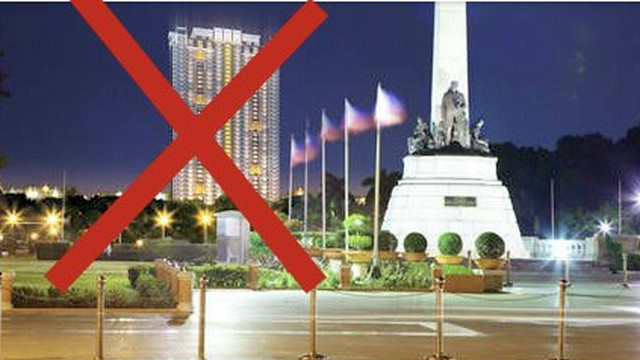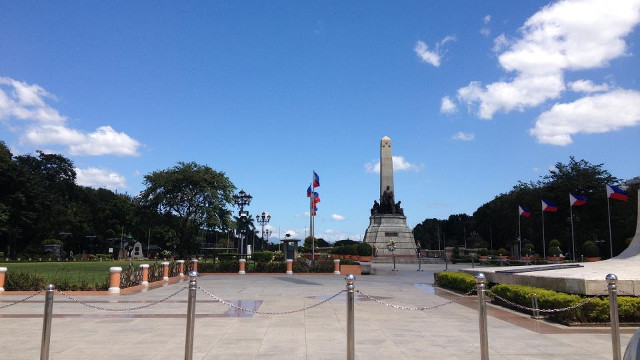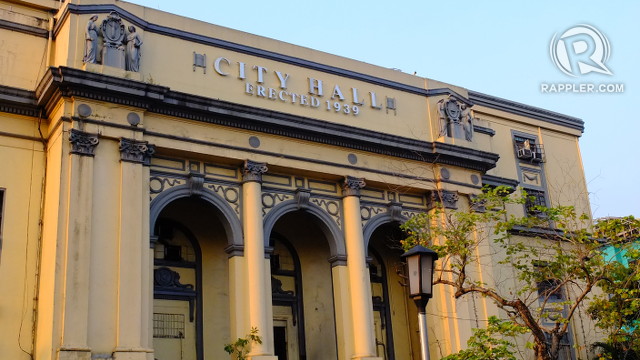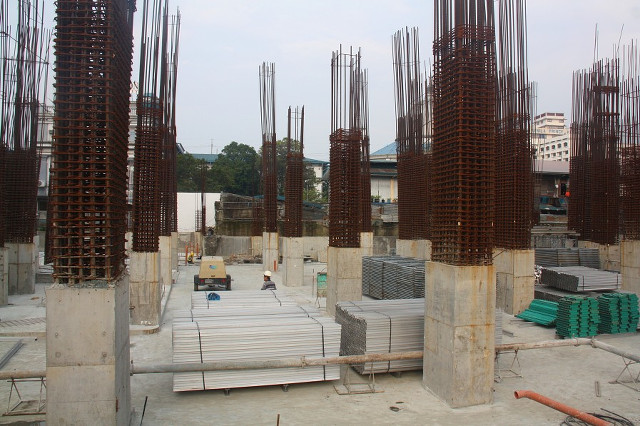SUMMARY
This is AI generated summarization, which may have errors. For context, always refer to the full article.

MANILA, Philippines – Where were the country’s cultural agencies when the controversial Torre de Manila project by DMCI Homes was approved?
Torre de Manila is a 46-story residential building currently being constructed between Rizal Park and Adamson University. Located within Manila City’s Institutional University Cluster, it is only allowed a maximum gross-floor-area-to-area-of-the-plot ratio of 4. (Gross floor area refers to the total floor area inside the building.) But based on construction plans, its floor area ratio will be 7.79, thus violating zoning laws under Ordinance No 8119.
But it’s the desecration of the national park across the street that bothers many Filipinos much more than the zoning violation. Once Torre de Manila is complete, it will rise behind the Rizal Monument, dwarfing the shrine and resting place of the national hero, ruining what heritage advocate Carlos Celdran calls “the sanctity of the Rizal sightline.”
Fierce opponents of the project have even renamed it “Terror de Manila,” dreading the day when they cannot take a photo of the Rizal Shrine without also capturing the high-rise condominium.
Celdran’s online petition urging Manila Mayor Joseph Estrada to suspend the building permit of Torre de Manila now has more than 7,900 signatures.
‘Conspiracy’
Public outcry against Torre de Manila was first heard in June 2012 when Celdran found out about the construction and raised a ruckus online. But DMCI countered that it had all the required building permits from City Hall.
The Manila City Council at the time then conducted an investigation on Melvin Balagot, the City Building official in charge of issuing permits for construction projects in the city. The investigation concluded that there was a “conspiracy” between Balagot and DMCI.
Both parties did not attend public hearings held by the Council to discuss Torre de Manila’s alleged violations. They also ignored the Council’s unanimously approved Resolution No 121 enjoining Balagot to “temporarily suspend the building permit of the Torre de Manila project until an acceptable development design is approved under proper compliance with the standards and policy guidelines set by the National Historical Commission.”
Construction continued. The City Council then decided to shift gears and oppose the project by citing its negative effects on the Rizal Shrine. DJ Bagatsing, a Manila councilor who was also a councilor at the time, contacted the National Historical Commission (NHCP) for their stance on Torre de Manila.
NHCP is the prime government agency dealing directly with national monuments and cultural and historical landmarks.
Republic Act 10066 or the National Cultural Heritage Act of 2009 gives the NHCP the power to issue a Cease and Desist Order “when the physical integrity of the national cultural treasures or important cultural properties are found to be in danger of destruction or significant alteration from its original state.”
The same law states that the “appearance of streets, parks, monuments, buildings…within a locality shall be maintained as close to their appearance at the time the area was of most importance to Philippine history as determined by the National Historical Institute.” (NHI is the former name of NHCP)
NHCP flipflops
When NHCP attended the June 22, 2012 hearing on Torre de Manila, their position was clear: Torre de Manila violates NHCP guidelines on monuments honoring national heroes.
In fact, according to Bagatsing who was present at the hearing, the NHCP representatives Wilkie Delumen and Crisanto Lustre presented the guidelines as basis for why DMCI’s project should not push through.
According to the guidelines which can be found in the NHCP website, the dominance of national monuments like the Rizal Shrine should be protected:
“Monuments should be given due prominence since they symbolize national significance…the Rizal National Monument in Luneta and the Bonifacio National Monument are established as objects of reference. The monument should preferably be the focal point of a city or town center.”
The guidelines further state that one measure for preserving dominance is to “keep vista points and visual corridors to monuments clear for unobstructed viewing appreciation and photographic opportunities.”

The guidelines seek to implement the constitutionally-enshrined directive that “all the country’s artistic and historic wealth constitutes the cultural treasure of the nation and shall be under the protection of the State which may regulate its disposition (Article VI on Arts and Culture, Section 16).”
But 6 months after the presentation, NHCP changed its stance.
NHCP Chairperson Maria Serena Diokno wrote to DMCI consultant Alfredo Andrade that DMCI need not worry about NHCP condemning the project.
“Your project site is outside the boundaries of the Rizal Park and well to the rear of the Rizal National Monument, hence it cannot possibly obstruct the front view of the said National Monument,” she wrote in the Nov 6, 2012 letter obtained by Rappler.
But in the next line, Diokno recommended that Manila City Hall enact “an ordinance designating a buffer zone around Rizal Park and prescribing guidelines building development” to prevent the recurrence of a similar “dilemma” in the future.
Bagatsing, who was counting on NHCP to support a dialogue between DMCI and stakeholders, was baffled by the agency’s sudden backing off.
To pursue the issue, he called NHCP Executive Director Ludovico Badoy but only got exasperated.
“I called him and asked, ‘Sir, what’s your take on this project?’ I got shocked because he said he was for it,” Bagatsing told Rappler.
Badoy said that Torre de Manila “does not violate any law.” When Bagatsing persisted that it would obstruct the vista of Rizal Shrine, Badoy allegedly said, “Bakit, sa gilid mayroon na (Why, on the sides there are already buildings),” referring to Eton Baypark Manila, another residential building.
At one point, Badoy raised his voice saying, “The board has already approved it. There’s nothing we can do.”
When Rappler asked Badoy for a clarification of NHCP’s support for the project, he merely repeated what Diokno said in her letter. When asked to explain the apparent contradiction between NHCP’s guidelines on preserving the monument’s sightline vista and Diokno’s statement that Torre de Manila “cannot possibly obstruct the front view” of the monument, Badoy did not reply.
[See original image here]
Protecting the sightline
Bagatsing is frustrated that NHCP is ignoring its own guidelines that would’ve nipped the Torre de Manila dilemma in the bud.
“That’s the only remaining unhampered sightline of the Rizal Shrine – the front view which is the most important perspective. Just because it already happened in the sides of the monument, doesn’t make it a good argument,” he said.
“The Rizal Shrine is called the national monument. It is the most important monument in the country. If NHCP is going to use technicalities for something that obviously will cheapen and degrade the sanctity of the Rizal Shrine, then there’s something wrong with that.”
All the Manila City Council wants is for a dialogue between DMCI and local stakeholders to take place, emphasized Bagatsing.
“We’re not even saying they cannot build Torre de Manila. There are ways to meet half-way. They can reduce the height of the building so it doesn’t ruin the sightline. They can put trees, change the design.”
With a new city building official in place and a new mayor, Bagatsing remains hopeful that the issue can be resolved. He is set to call for a resolution once more to temporarily suspend Torre de Manila’s building permit. He also plans to seek the support of the National Commission for Culture and the Arts (NCCA), a commission even higher than the NHCP.
Meanwhile, “Terror de Manila” construction continues. According to DMCI’s website, as of October 14, the foundation is now complete and the slab fill for the first level is 45% complete. The higher the building rises above ground, the harder it will be to stop or change its construction plans. – Rappler.com
Add a comment
How does this make you feel?


There are no comments yet. Add your comment to start the conversation.